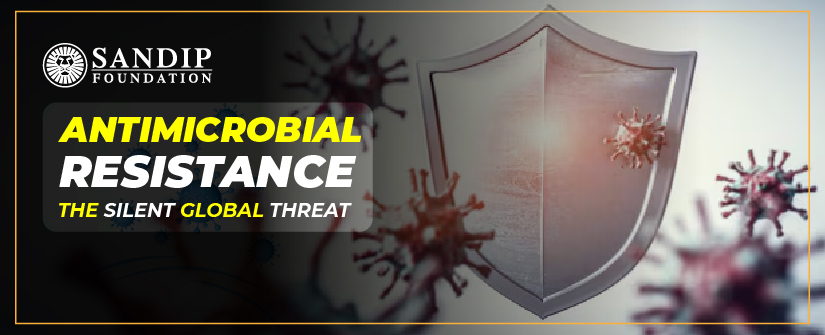Just think about a world where common infections can kill, where common surgeries could put people’s lives at risk, and where the medicines we depend on no longer work. This isn’t science fiction—it’s the growing reality of antimicrobial resistance (AMR). Many top pharmacy colleges in Nashik are conducting path-breaking research into the increasing levels of antimicrobial resistance around the world.
While many of them would not live, those who did were resistant to other poisons, and their bodily fluids would be toxic to others. Antimicrobial resistance is a global problem that affects multiple domains including healthcare, agriculture, aquaculture, and many more. AMR is not a novel but has evolved over centuries, with its roots tracing back to ancient times. AMR has significant effects on both health systems and national economies overall.
What is Antimicrobial Resistance?
Antimicrobials are medications used to prevent and cure infectious infections in people, animals, and plants. These include antibiotics, antivirals, antifungals, and anti-parasitic. When bacteria, viruses, fungi, and parasites develop immunity against antimicrobial medications, it is known as antimicrobial resistance, or AMR. Drug resistance raises the risk of disease transmission, serious sickness, disability, and death by making antimicrobial agents ineffective and making it harder or impossible to treat infections.
Why does AMR Occur?
AMR develops naturally as a result of infections’ genetic alterations over time. Human activity, particularly the abuse and overuse of antimicrobials to treat, prevent, or control illnesses in humans, animals, and plants, accelerates its establishment and spread.
Antibiotic resistance is spread by humans, animals, crops, and the foods we eat. We used antimicrobial agents excessively for illness that causes mutation of microorganisms. Thus they develop immunity against antimicrobial agents. These resistant pathogens are spread if food is not cooked properly. Through food they enter the human and animal gut. From there they spread to crops through faecal matter through soil and water and the cycle continues. Microorganisms that develop antimicrobial resistance are also called “superbugs”.
Causes of AMR
- Overuse and misuse of antimicrobials without medical supervision is the main reason behind increasing AMR rate.
- Misuse in agriculture, where antibiotics are used to promote animal growth.
- Lack of proper sanitation practices and availability of clean water can cause easy spread of infections
- Substandard and adulterated drug may contain low doses of API and thus develops resistant
- Microbes naturally evolve and adapt to their environment, and those that are resistant to a specific drug are more likely to survive and reproduce, leading to an increase in resistance over time
Why Should We Care?
- Health Impact: Resistant infections lead to longer illnesses, more hospital stays, and higher mortality rates.
- Global Spread: These “superbugs” can travel across borders through people, animals, food, and water.
- Medical Setbacks: Without effective antibiotics, procedures like organ transplants, chemotherapy, and even childbirth become far riskier
What Can We Do?
- We should optimise the use of antimicrobials: Only take when prescribed, and always finish the full course.
- Avoid buying antibiotics without prescription and avoid pressuring doctors for antibiotics when they aren’t necessary.
- Do not share prescription and leftover medicines with others.
- Practice good hygiene: Implementing good hygiene practices, proper hand washing, isolating infected patients in healthcare settings and staying up-to-date on vaccinations prevents infections in the first place.
- Development of new antimicrobial drugs: Investing in research and development of new antimicrobial drugs is crucial for addressing the growing threat of AMR
- Support global action: we should contribute to global AMR surveillance program and funding antibiotic research
Global Action to Address AMR
AMR is a problem for all countries at all income levels. Its spread does not recognise country borders.
In order to promote AMR surveillance and provide awareness about AMR, the WHO Global Antimicrobial Resistance and Use Surveillance System (GLASS) was introduced in 2015. Firstly, this system began with monitoring AMR in bacteria that cause frequent human illnesses then it has grown to monitor invasive fungal infections, antimicrobial consumption (AMC), and a One Health surveillance model for human health. Data of evolving AMR and AMC is important in order to face future concerns. As of the end of 2022, 127 countries, territories, and areas are part of GLASS.
A global initiative, World AMR Awareness Week (WAAW) aims to increase public awareness, knowledge, and best practices among Health stakeholders and other officials. The World Health Organisation’s official health campaign, WAAW, has been observed from 18 to 24 November every year since 2015.
During the 2015 World Health Assembly, nations adopted the Global Action Plan (GAP) on AMR and pledged to create and carry out multisectoral national action plans using a One Health approach to combat AMR.
The Indian government supports range of activities and initiatives that are in line with priorities of India’s National Action Plan on AMR (NAP-AMR), including development of sub-national action plans, AMR awareness and understanding activities, networks for surveillance of AMR and antimicrobial consumptions and use, preventing and controlling infections, optimising antimicrobial use, encouraging research and innovations – in coordination and collaboration with key stakeholders, including the Quadripartite organisations.
The Bottom Line
According to a fact sheet published by WHO, antimicrobial resistance (AMR) is one of the greatest threats to modern medicine and global public health. Bacterial AMR is believed to have contributed to 4.95 million fatalities worldwide in 2019 and been solely accountable for 1.27 million deaths. Professionals holding a Bachelor of Pharmacy degree are capable of tackling this issue through research and helping the medical community find a solution to antimicrobial resistance. It is a slow-moving crisis, but one we still have time to stop—if we act wisely today. Every prescription counts. Every decision matters.

